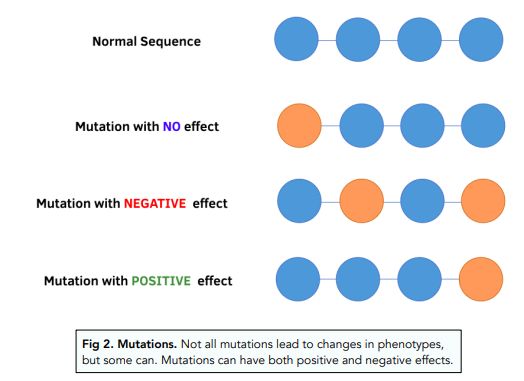Variation - Variation and Its Causes (GCSE Biology)
Variation and Its Causes
Genotypes and Phenotypes
Key Terms
A genotype is the collection of genes an organism has. This is inherited from the parents.
A phenotype is the physical characteristics of an organism. All organisms all have different appearances and characteristics – i.e. different phenotypes. The phenotype is determined by environmental and genetic factors.
Variation is the differences in phenotypes in a population. There can be variation in physical appearance (e.g. different weight), social factors (e.g. personality), academic factors (e.g. natural talents), and much more.
Continuous variation results in a range of phenotypes between two extremes e.g. weight and height in humans.
Discontinuous variation results in a limited number of phenotypes with no intermediates but instead distinct groups e.g. ability to roll your tongue. It is mostly caused by one gene without environmental influence e.g. A, B, AB and O blood groups in humans.
Genotypic variation is the differences in genotype.
Phenotypic variation is the differences in the phenotypes expressed. Genotypic variation can cause phenotypic variation and environmental factors can also cause phenotypic variation.
Environmental variation is the differences in phenotype causes by the environment. Hence, they are acquired characteristics e.g. your accent.
Reasons for Variation
There are many reasons for variation:
- Genes – the set of genes that have been inherited from the mother and father can control many characteristics. For example, blood type is controlled by genes only, there is no environmental influence. Other examples of genetic phenotypes are natural eye colour and the ability to roll your tongue.
- Environment – the environment in which an organism grows and develops will play a large role in phenotype. For example, an accent is controlled solely by the environment.
- Genes and Environment– the majority of factors are not solely controlled by either variable. Weight for example is a cross of both – even if both parents of a child have a low metabolism and are overweight, they may still have a very light child, as the weight is dependent also on environmental factors such as diet and exercise.
Variation in Species
Variation Between and Within Species
Variation can occur either:
- Between species – individuals in different species tend to be very different and have lots of variation. For example, a lion has a tail whereas a human does not.
- Within species – individuals of the same species tend to have more similarities and have less variation than individuals of different species. They tend to produce similar proteins and have a similar body anatomy, but genetic variation is almost always present. These variations arise through mutations.

Mutation and Variation
Variation occurs within species due to mutations, which we learnt about earlier. Mutations are a spontaneous, random change in genetic material due to a mistake in replication and they can form new alleles.
When the genetic material is duplicated during reproduction, a mutation can occur leading to a change in genotype. However, this does not always lead to a change in the phenotype.
Sometimes the mutation is silent, which means that it doesn’t affect the final phenotype. Sometimes mutations have a small effect on the phenotype and, rarely, a single mutation will significantly affect the phenotype. These mutations can lead to the new organism having different features. If the mutation is beneficial, it can give the new organism an advantage and can therefore be passed on to then next generation. We will learn more about this in the next tutorial on natural selection.

Sexual Reproduction and Variation
- Sexual reproduction can also cause variation. The mixing of the maternal and paternal chromosomes during meiosis in the formation of gametes gives rise to variation.
- Random fertilisation of gametes also produces genetic variation of offspring. This is because any female gamete can fuse with any male gamete e.g. an egg or sperm in humans.
Variation refers to the differences that exist between individuals of a species. This can include differences in physical characteristics, behavior, and genes.
Variation is important because it allows populations to adapt to changing environments. Individuals with favorable variations are more likely to survive and reproduce, passing on their favorable traits to future generations. Over time, this process of natural selection can lead to the evolution of new species.
There are several causes of variation, including genetic factors, environmental factors, and random events.
Genetic factors are variations that are inherited from parents. They are caused by differences in genes or changes in the DNA sequence.
Environmental factors refer to variations that are caused by external factors, such as diet, climate, and disease. These factors can influence the expression of genes, leading to differences in physical characteristics and behavior.
Random events refer to variations that occur due to chance events, such as mutations. Mutations are changes in the DNA sequence that can lead to new traits and variations.
Genetic factors, environmental factors, and random events interact to cause variation by influencing the expression of genes. For example, a genetic factor may make an individual more susceptible to a certain disease, but it is the environment (e.g. exposure to a pathogen) that triggers the expression of the disease. Random events, such as mutations, can also lead to new variations that may or may not be favorable.
It is important to understand variation and its causes because it helps us to understand the diversity of life and how species evolve over time. This knowledge can also be applied to fields such as medicine and agriculture, where understanding variations can lead to the development of new treatments and crops.






Still got a question? Leave a comment
Leave a comment